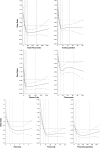Flavonoid intake and cardiovascular disease mortality in a prospective cohort of US adults
- PMID: 22218162
- PMCID: PMC3260072
- DOI: 10.3945/ajcn.111.016634
Flavonoid intake and cardiovascular disease mortality in a prospective cohort of US adults
Abstract
Background: Flavonoids are plant-based phytochemicals with cardiovascular protective properties. Few studies have comprehensively examined flavonoid classes in relation to cardiovascular disease mortality.
Objective: We examined the association between flavonoid intake and cardiovascular disease (CVD) mortality among participants in a large, prospective US cohort.
Design: In 1999, a total of 38,180 men and 60,289 women in the Cancer Prevention Study II Nutrition Cohort with a mean age of 70 and 69 y, respectively, completed questionnaires on medical history and lifestyle behaviors, including a 152-item food-frequency questionnaire. Cox proportional hazards modeling was used to calculate multivariate-adjusted hazard RRs and 95% CIs for associations between total flavonoids, 7 flavonoid classes, and CVD mortality.
Results: During 7 y of follow-up, 1589 CVD deaths in men and 1182 CVD deaths in women occurred. Men and women with total flavonoid intakes in the top (compared with the bottom) quintile had a lower risk of fatal CVD (RR: 0.82; 95% CI: 0.73, 0.92; P-trend = 0.01). Five flavonoid classes-anthocyanidins, flavan-3-ols, flavones, flavonols, and proanthocyanidins-were individually associated with lower risk of fatal CVD (all P-trend < 0.05). In men, total flavonoid intakes were more strongly associated with stroke mortality (RR: 0.63; 95% CI: 0.44, 0.89; P-trend = 0.04) than with ischemic heart disease (RR: 0.90; 95% CI: 0.72, 1.13). Many associations appeared to be nonlinear, with lower risk at intakes above the referent category.
Conclusions: Flavonoid consumption was associated with lower risk of death from CVD. Most inverse associations appeared with intermediate intakes, suggesting that even relatively small amounts of flavonoid-rich foods may be beneficial.
Figures

Comment in
-
Flavonoids [corrected] and blood pressure.Am J Clin Nutr. 2012 Feb;95(2):271. doi: 10.3945/ajcn.111.031112. Epub 2011 Dec 28. Am J Clin Nutr. 2012. PMID: 22205308 No abstract available.
Similar articles
-
Flavonoid intake and cardiovascular disease mortality: a prospective study in postmenopausal women.Am J Clin Nutr. 2007 Mar;85(3):895-909. doi: 10.1093/ajcn/85.3.895. Am J Clin Nutr. 2007. PMID: 17344514
-
Dietary Flavonoid Intake Reduces the Risk of Head and Neck but Not Esophageal or Gastric Cancer in US Men and Women.J Nutr. 2017 Sep;147(9):1729-1738. doi: 10.3945/jn.117.251579. Epub 2017 Jul 19. J Nutr. 2017. PMID: 28724656 Free PMC article.
-
Flavonoid intake and risk of CVD: a systematic review and meta-analysis of prospective cohort studies.Br J Nutr. 2014 Jan 14;111(1):1-11. doi: 10.1017/S000711451300278X. Epub 2013 Aug 16. Br J Nutr. 2014. PMID: 23953879 Review.
-
Dietary epicatechin intake and 25-y risk of cardiovascular mortality: the Zutphen Elderly Study.Am J Clin Nutr. 2016 Jul;104(1):58-64. doi: 10.3945/ajcn.115.128819. Epub 2016 May 25. Am J Clin Nutr. 2016. PMID: 27225434
-
Flavonoid intake and mortality from cardiovascular disease and all causes: A meta-analysis of prospective cohort studies.Clin Nutr ESPEN. 2017 Aug;20:68-77. doi: 10.1016/j.clnesp.2017.03.004. Epub 2017 Apr 28. Clin Nutr ESPEN. 2017. PMID: 29072172 Review.
Cited by
-
Protein disulfide isomerase as an antithrombotic target.Trends Cardiovasc Med. 2013 Oct;23(7):264-8. doi: 10.1016/j.tcm.2013.03.001. Epub 2013 Mar 27. Trends Cardiovasc Med. 2013. PMID: 23541171 Free PMC article. Review.
-
Effect of Isoflavone on Muscle Atrophy in Ovariectomized Mice.Nutrients. 2024 Sep 28;16(19):3295. doi: 10.3390/nu16193295. Nutrients. 2024. PMID: 39408262 Free PMC article.
-
Dietary flavonoid intake and risk of incident depression in midlife and older women.Am J Clin Nutr. 2016 Sep;104(3):704-14. doi: 10.3945/ajcn.115.124545. Epub 2016 Jul 13. Am J Clin Nutr. 2016. PMID: 27413131 Free PMC article.
-
Sulfation of Phenolic Acids: Chemoenzymatic vs. Chemical Synthesis.Int J Mol Sci. 2022 Dec 2;23(23):15171. doi: 10.3390/ijms232315171. Int J Mol Sci. 2022. PMID: 36499496 Free PMC article.
-
Oxidative Stress in Cardiovascular Diseases: Still a Therapeutic Target?Nutrients. 2019 Sep 4;11(9):2090. doi: 10.3390/nu11092090. Nutrients. 2019. PMID: 31487802 Free PMC article. Review.
References
-
- Rosamond W, Flegal K, Furie K, Go A, Greenlund K, Haase N, Hailpern SM, Ho M, Howard V, Kissela B, et al. Heart disease and stroke statistics–2008 update: a report from the American Heart Association Statistics Committee and Stroke Statistics Subcommittee. Circulation 2008;117:e25–146 Erratum in: Circulation 2010;122(1):e10 - PubMed
-
- Abbott AL. Medical (nonsurgical) intervention alone is now best for prevention of stroke associated with asymptomatic severe carotid stenosis: results of a systematic review and analysis. Stroke 2009;40:e573–83 - PubMed
-
- Dauchet L, Amouyel P, Dallongeville J. Fruits, vegetables and coronary heart disease. Nature Reviews. Cardiology 2009;6:599–608 - PubMed
-
- Appel LJ, Moore T, Obarzanek E, Vollmer W, Svetkey L, Sacks F, Bray G, Vogt T, Cutler J, Windhauser M, et al. A clinical trial of the effects of dietary patterns on blood pressure. N Engl J Med 1997;336:1117–24 - PubMed
Publication types
MeSH terms
Substances
Grants and funding
LinkOut - more resources
Full Text Sources
Other Literature Sources
Medical

